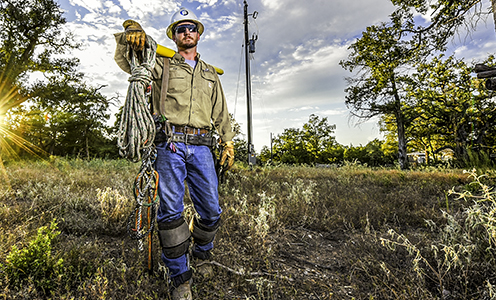Voices of Veterans
Recent news
Lavender farms have firmly taken root, and more growers are experimenting with unusual crops across the Bluebonnet region
Story by Eric Webb l Photos by Laura Skelding
It's Saturday morning, and you’ve filled your farmers market bag with the staples — tomatoes, carrots, melons, peppers and a few fresh herbs. Now your wandering eye spots something surprising — pomegranates, figs, turmeric, tea from a native plant and an assortment of fragrant flowers.

Those and other interesting items are popping up at farmers markets, farm-to-table restaurants and farmers’ online shops in the Bluebonnet Electric Cooperative service area.
More growers across the Bluebonnet region are experimenting with unusual crops
Some growers want to diversify their operations. Others are willing to invest sweat equity into cultivating something different (like the lavender farms profiled on the following pages). Some turn a common native plant, like yaupon holly leaves, into tea.
Then there are flower fans, such as the folks at Antique Rose Emporium in Washington County, who keep Texas’ oldest rose varieties thriving.
“When you think of a small farm or ranch, they may only be able to sustain a handful of livestock,” said Chase Brooke, a specialist on small farms and ranches for the Texas A&M AgriLife Extension Service.
“Each farm and ranch is a connection for that community,” Brooke said. The popularity of farm-to-table restaurants in both small towns and big cities proves those connections are valuable.
John Grange is Burleson County’s agent for the extension service. For more than a decade, he has studied the county’s farming and ranching community, overseen the farmers market, and advised both new and established producers on everything from weed management and livestock care to getting the most out of their property.
“The majority of new landowners are small-acreage farmers, most in the 5- to 20-acre tract size,” he said. At the farmers market, Grange has seen the offerings expand from produce, meats and eggs to more varied items, such as baked goods, plants and homemade products like jellies and soaps.
His advice to any would-be producer: “Know your soil types and weather conditions of the area.”
Chappell Hill Lavender Farm
On a clear spring day, driving down FM 1155 a few miles northeast of Brenham feels like tunneling through a kaleidoscope. Verdant trees curve overhead, their branches touching, giving way to a brilliant blue sky. On the landscape, patches of fiery Indian paintbrushes warm the palette.

Then, about half a mile down a side road, you hit the silvery purple payload.
Chappell Hill Lavender Farm cultivates its namesake perennial flowering shrub, renowned for a calming aroma and homeopathic properties, on about 4 acres. This farm and Luling Lavender Fields are the two largest operations dedicated to the tricky art of coaxing lavender to bloom in the Bluebonnet Electric Cooperative service area.
Lavender has been used for at least 2,500 years for everything from bathing and cleaning to medicine and mummification. Now it’s likely to show up in soothing soaps, relaxing sleep aromatherapy and beauty products.
The plant has more than 450 varieties and is native to the Mediterranean, according to the U.S. Lavender Growers Association. It loves lots of sun, dry and rocky soil and temperatures in the 60- to 85-degree range. Stateside, you’re most likely to find it flourishing on huge farms in the Pacific Northwest. That raises the question: How can it survive in Texas’ hot, humid summers and occasional bitter winter freezes?
Growing lavender requires patience, practice, adaptability and a willingness to accept challenges. When conditions are right, a flourishing lavender crop — with its calming scent and picturesque blooms — can draw a crowd.
“I read something that said two out of every three people are stressed out these days,” said Debbie McDowell, who started the Chappell Hill farm with her husband, Jim, in 2003. “It's obvious with all the things going on, your work, your job, traffic, people are looking for something to help them relax.”
The town of Chappell Hill is known for its Bluebonnet Festival every spring, but there’s no bad blood between these blooms. McDowell happily welcomes guests whose floral preferences lie a notch over on the color spectrum. Visitors often come to the farm as part of Brenham day trips or weekend escapes, traveling from other areas in the Bluebonnet region, and the big cities not far beyond.
The McDowells lived in Houston before they sought retirement in paradise. “When we moved out here, it was all raw land,” Debbie said. She and Jim saw potential in the shade trees and a green hill rolling down to a pond. They’ve added a gazebo, three miniature goats and, of course, orderly rows of lavender bursting out of the ground. By Debbie’s estimate, around 1,500 plants are growing this spring.
Before they founded the farm, Debbie had some gardening experience but was no farmer. Admittedly, she thought of lavender as a laundry detergent scent. Inspired by a segment on a TV show, the couple bought a flat of lavender plants and stuck them in the ground, just to see what would happen.
The lavender did pretty well. So, they cleared the field and bet on purple.
The McDowells grow two varieties best suited to Washington County’s climate: Provence and Sweet lavender, with blooms that are a cool, almost silvery shade of purple, more ethereal than royal. Intensely purple varieties of lavender don’t grow as well in Central Texas, Debbie said.
The Sweet lavender blooms first, between April and June. The Provence lavender, a culinary favorite, blooms July through September. Looking for another way to keep guests coming between lavender seasons, the McDowells planted fruit trees on their property a few years back. Peaches, figs, pears, persimmons and even blackberry bushes now grow a few yards away from the lavender beds.
Nature has been a tough teacher. Originally, the McDowells planted in long rows, but as the lavender grew close together, high humidity caused problems.
“They didn’t get enough airflow to dry the plant out,” Debbie said. “Moisture is lavender’s number one enemy.” They learned to space plants out and make rows shorter.
“In October or November, we plant and pray that we don’t have a freeze,” Debbie said. “If we have a hard freeze, we pull everything out, and we start over.”
“The progress that we’ve made through the years, as far as learning what worked better for the plants and the products, I think that’s what I’m most proud about,” she said. “Because it takes time — a lot of ups and downs — to get there.”
Leaving the gift shop, Debbie strolls along the rows of Sweet lavender. She snips a single stem decorated with spiky flowers and holds it up. It gently bends to gravity, curving downward. The plants need more sunlight and time in the ground, she said, before they’re ready for eager visitors to snip.
“The people that come out here are just very special people,” Debbie said. “They’re the type of people that appreciate nature, flowers, serenity, quiet.”
Luling Lavender Fields

Luling Lavender Fields is owned by a couple who figured out the art of growing lavender in the region over time. Richard and Erin Leavitt wanted to make use of 10 acres of family land, easily accessible from the detour-friendly intersection of U.S. 183 and Interstate 10, a few miles southeast of downtown Luling. Erin’s late father, Bill Watson, bought the land in 1955, the year she was born.
The Leavitts visited lavender farms in the state of Washington, where Erin’s sister lives, doing field research to find a crop that could generate income. Once back in Luling, Richard set up an irrigation system on their land, punched the ground with a post-hole digger and sprinkled a little nitrogen-rich bone meal into the soil to help achieve the neutral pH that lavender likes. In 2017, they planted 2,000 lavender plants on 2 acres.
The planter boxes where their lavender grows are painted the color of their contents. Elsewhere in the field, a gazebo, a bicycle, an old flatbed truck and a flamingo figure are the same hue.

The Leavitts grow a few lavender varieties, including Super Blue and English. Once the tall Super Blue starts blooming in the spring, it doesn’t stop until the first freeze of winter, Erin said. Its flowers make great dried bundles, Richard said. The shrubby English lavender, often used in cooking, is more seasonal, usually blooming in April and fading by June.
Unpredictable weather isn’t the only challenge this farm deals with. Richard regularly faces off against thirsty fire ants that move into the drip lines and gophers’ tunnels that disrupt the plants’ root systems.
“This used to be a rock quarry in the ’40s,” Erin said. “My family gave it to me because nobody wanted it.”
Thanks to those rocks, the fields have great drainage. Lavender hates wet feet, which leads to root rot. Many amateur gardeners make the mistake of giving lavender too much water, Erin said.
The Leavitts’ shop sells a variety of starter plants that visitors can take home (as does Chappell Hill Lavender Farm). Erin always asks where folks live before giving out advice. Land with sandy soil works best for growing lavender in the Bluebonnet region, especially with all-day sun and a little fertilizer. Clay soil traps moisture, though, so folks in those regions should opt for a raised bed or a pot that gets morning sun and afternoon shade.
“The way I water, I call it ‘drowned and dry,’ ” Richard said. His advice to home growers: “Let that pot dry out. When it’s dry, then you just want to drown it with water — pour way more water than you’d ever think — and then let it dry out for a couple days.”
Until recently, rows of lavender were there simply to admire. But last June, they allowed visitors to snip their own souvenirs for a change. It was a hit, so they let folks pick their own bundles again this spring.
“We couldn’t believe how many people did it in 100-degree heat, when the blooms were not great,” Erin said. “We realized it isn’t hard to do, and our visitors love it.”
Perfect scents
By late April, it’s cutting time back at Chappell Hill Lavender Farm. On a perfect spring Saturday, sunny enough for a body to sweat but windy enough to dry it off, visitors pack the gift shop. Debbie McDowell and two assistants do it all — ring up customers, bundle fresh-snipped lavender and pour lemonade.
The gift shop offers proof that lavender can be used in myriad ways. The shelves feature several different spice blends. You can pick up lavender fudge or the farm’s signature crunchy cookie with lavender. There are aromatherapy products made with essential oil. Handmade soaps rival anything you’d find at a big-box store. Lavender mosquito spray is a bestseller.
Debbie makes some of the products herself, as does Erin Leavitt for her own well-stocked gift shop in Luling. On the shelves, visitors will find Erin’s lotions and potions. A painted shelf reading “lots of love, laughter and lavender” holds body products, like sugar scrubs, foaming bath salts and bars of soap. Elsewhere, there are sachets of dried lavender and boxes of lavender tea.
The Leavitts sell some of Luling Lavender Fields’ blooms in bundles, but they also source many of the gift shop’s goods from outside suppliers, including other small farms.
At Chappell Hill Lavender Farm, employees give a pair of scissors and a flat-bottomed wicker basket to anyone looking to snip something. Bees and butterflies flit around people’s fingers. Bursts of fragrance hit their noses whenever their scissors sever a stem from its sisters.
It’s calming carnage.
That soothing effect is what draws visitors to Luling Lavender Fields, too. “Lavender has reached the consciousness of the public as something that's really good for you,” Erin said. “It’s natural. It’s relaxing.” Their field welcomes all kinds of folks looking for the purplish peacemaker — girlfriends on weekend excursions, families with rowdy kids, curious groups from assisted living facilities.
Lavender plants often flummox Central Texas gardeners. On that April day at Chappell Hill Lavender Farm, hopes sprang eternal. Undoubtedly, many of the day’s visitors drove out the gate and into the kaleidoscope, their car thick with that clean, soothing scent and their minds filled with visions of lavender blooms in their back yards.
— Melissa Segrest contributed to this story
Chappell Hill Lavender Farm
2250 Dillard Road, Brenham Farm and gift shop open March through November; 10 a.m.-2 p.m. Thursday and Friday, 9 a.m.-5 p.m. Saturday, 11 a.m.-4 p.m. Sunday. Open by appointment only December-February; holiday hours vary. 979-251-8114 chappellhilllavender.com
Luling Lavender Fields
5 Arrow Lane, Luling Fields and gift shop open 10 a.m.-5 p.m. daily 830-351-4609 lulinglavenderfields.com
Bluebonnet Electric Cooperative will send lineworker interns, journeymen, judges and a barbecue team to compete in the annual Texas Lineman’s Rodeo, set for July 19 at Nolte Island Recreation Area near Seguin.
This rodeo is not for cattle and cowboys. Lineworkers compete against others from electric utilities across the state in intense, timed challenges that showcase skills they perform every day, such as climbing utility poles, repairing power lines and fixing equipment.
One of the most challenging events is the pole-top rescue. Competitors must simulate saving an injured lineworker, using a human-sized mannequin. These events test their precision, speed and safety under pressure.
Bluebonnet’s teams will be joined by families and guests to support the event.
The competition takes place in a field near the Guadalupe River, with de-energized utility poles set up for the events, and is open to the public.
Come cheer on Bluebonnet’s team members or follow their progress on Bluebonnet’s social media pages throughout the day.
For more details, visit tlra.org.
Here’s how to save on electricity while you’re away
As you get ready for your summer vacation, you’re probably thinking about bumping up your thermostat to save electricity and money. There are more ways to save electricity costs and keep your home safe while you’re away. Try these simple tips to save money and conserve electricity:
Raise your thermostat just 4 to 5 degrees higher. Turning it up too much can cause your refrigerator to work harder, using more electricity. Keeping your AC running at a slightly higher temperature also helps control humidity, reducing the risk of mold and mildew.
Before leaving, also:
- Turn off water: Shut off water to sinks, toilets and washers to prevent leaks or flooding.
- Close blinds or shades: Partially close blinds or shades. This blocks out the sun’s heat but creates the perception that someone is home.
- Use light timers: Set lights on timers or use your smart home system to simulate activity at home and avoid wasting electricity.
Find more tips HERE.
More growers across the Bluebonnet region are experimenting with unusual crops
SMALL TOWN FARM
Fentress
Turmeric, cardamom, papaya, curry leaf trees and more
IF YOU GO
San Marcos Farmers Market,
111 E. San Antonio St.
9 a.m.-1 p.m. Saturday (preorder plants online)
smalltownfarmtx@gmail.com
smalltownfarm.com
Cristen Andrews and Miguel Guerra used to visit Caldwell County and find campsites around the area. After 20 years of visiting, they put down roots there in 2020.
Lavender farms have taken root
The couple follows an expansive growing philosophy at Small Town Farm in Fentress. “We feel like it’s really important to get to know the plants, seed to harvest,” Andrews said. They stay mindful of their surroundings: what’s native, what the local wildlife eats, what weeds tend to pop up. Different species mingle in their garden. It is not a place of orderly rows.
Small Town Farm's owners respond to what nature is saying by adapting their practices to the changing environment. “We’ve been picking more and more plants that tend to be able to survive in our current climate, not what we’re used to,” Guerra said.
Andrews and Guerra grow several crops that don’t bring Texas to mind, like turmeric, the ginger relative native to Southeast Asia. The leafy flowering plant’s rhizomes (or rootstalks), when dried and powdered, become a vibrant yellow spice used in many Asian dishes.
The same is true with turmeric’s cousin galangal, another leafy flowering plant whose rhizome is often used in Thai cuisine. The farm’s cardamom, yet another ginger family member, also has similar growing preferences.
The two owners of Small Town Farm have dabbled with papaya, a tropical fruit native to Mexico and Central America. Their papaya trees grew from seeds from a grocery store fruit. If they can weather a winter, they grow fast and can shoot up taller than a house, making them great shade umbrellas. Guerra’s favorite plants at the farm are the curry leaf trees, native to India. Small Town Farm has also grown Armenian cucumbers, which are melons, botanically speaking, but taste like cucumbers; Kajari melons, also known as Indian honeydews; and snake gourds, also known as snake beans.
“You can plant year-round,” she said. “It just depends on what you’re planting.”
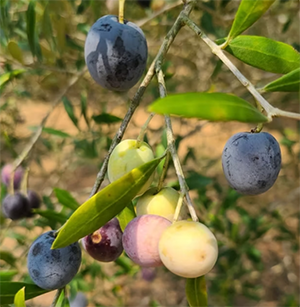
DELL’S FAVORITE TEXAS OLIVE RANCH
Elgin
Olive oil and private-label jars of olives
IF YOU GO
186 Youngs Prairie Road, Elgin
9 a.m.-6 p.m. Saturday and Sunday
512-229-8443
fmajfarm@gmail.com
dellsfavorite.com
The party starts at Dell’s Favorite Texas Olive Ranch when it’s time to harvest the goods in the fall.
Frank and Renee Majowicz, who own the Elgin orchard, host a volunteer team that gets a crash course in olive picking and enjoys a community meal in exchange.
Frank should know a thing or two about hospitality, since he was a corporate chef for Hyatt Hotels for 43 years before retiring in 2020. Anticipating the need for a new project, the Majowiczes planted their first olive trees in the 3½-acre orchard in 2014. They primarily grow Arbequina olives, which are native to Spain, Renee said. The fruit is aromatic and purple to dark brown in color when ripe.
Dell’s Favorite Texas Olive Ranch turns that fruit — yes, it’s fruit — into olive oil, which they have pressed at a mill in Hallettsville. Arbequina oil is mild and subtly sweet. The Majowiczes also sell a private label of jarred olives from another source. The little guys that they grow themselves are used only for oil, Renee said.
Olive trees love the sandy loam of their Bastrop County orchard, which drains well. Like lavender, olives don’t like wet feet. The trees start budding in March and mature from late September through early October.
Texas heat doesn’t bother the trees much, Renee said, thanks to the orchard’s irrigation system. But especially cold winters have been a challenge. The big freeze of 2021 took its toll on the orchard, and in 2024, the Majowiczes planted 450 new trees to replace those they lost.
“They are technically evergreen,” Renee said. “So, if the weather stays right, the trees should stay green all year.”
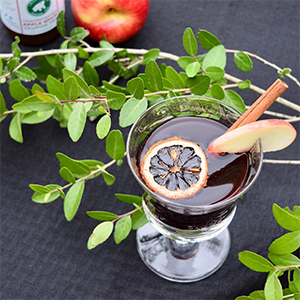
Lost Pines Yaupon Tea photo
LOST PINES YAUPON TEA
Bastrop
Roasted yaupon tea leaves and flavored tea concentrates
TRY YAUPON TEA
Purchase teas and merchandise on their website or find them at select retailers in Austin, San Marcos and Lockhart (store hours vary)
512-748-4546
lostpinesyaupontea.com
A few years ago, Jason Ellis heard that the leaves of the yaupon holly, a native shrub in many Texas landscapes, could be brewed into a caffeinated tea. “It must taste awful if nobody's actually doing anything with it,” he remembers thinking.
In fact, Indigenous people have made yaupon leaves into a beverage since ancient times. Colonists even exported it to Europe. Yaupon tea eventually faded from popular use, but the plant didn’t go anywhere.
Yaupon is so plentiful in the Bluebonnet Electric Cooperative region, particularly in Bastrop County’s Lost Pines, that people are willing to pay to get rid of it. So, along with friends Heidi Wachter and John Seibold, Ellis founded Lost Pines Yaupon Tea, which turns the unwanted greenery into liquid gold. If you ask Ellis, it tastes great.
Yaupon is a native plant to the region and incredibly well-adapted to its home, Ellis said. After any brush-clearing, it is one of the first woody plants to reappear. Yaupon Tea crews drive to areas overgrown with the plant, then trim and remove branches. That work gives other native plants a better chance to flourish, Ellis said.
Ellis and company take the yaupon back to their warehouse, let the leaves air dry and then roast them in a convection oven. Their light roast tastes like green tea, while the dark roast is comparable to a “really roasty, oaky, almost whiskey barrel-ish black tea,” he said. The company also sells flavored yaupon tea concentrates, like mint, basil and peach.
Inevitably, the yaupon grows back, so Ellis and his crew return to trim again. There’s no chance Lost Pines could ever run out of their tea supply, he said. They’ve even had to turn away some property owners who asked them to clear their yaupon.
“It's literally the predominant understory to the entire pine forest,” Ellis said.
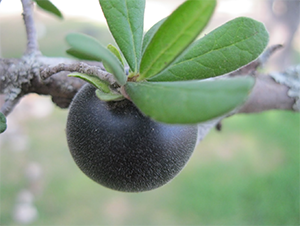
TWISTED TIMBER FARMS
Lexington
Persimmons, jujubes, pond plants and more
WANT TO FORAGE OR SHOP?
Call 512-818-5278 for information to plan a visit
Get event details on the Lee County Gardening Club Facebook group
Buy products at the Buffalo Bazaar Community Market, 119 N Burleson St., Giddings; 9 a.m.-2 p.m., second Saturday, March-November
When the COVID-19 pandemic strained food supply chains, it inspired Kathleen Canales to take action. She now spreads the gospel of growing good stuff to feed the community.
Canales moved to Lexington from Hutto about six years ago. She runs Lee County Garden Club, which aims to make sustainable food production available to anyone, offering meetups, seed swaps, farm tours, classes and more. She also grows a variety of plants on her 10 acres called Twisted Timber Farms.
She speaks excitedly about all the crops people might not know they can grow in the area. Pomegranates and figs can do well in Lee County, Canales said. Mustang grapes thrive, and some folks turn them into jelly to sell at the Lee County Farmers Market.
Native Texas persimmons grow on Canales’ land. The trees aren’t very big (under 10 feet) and the fruit they bear is small, too. One of the more interesting plants she grows is the jujube. Not to be confused with the candy of that name, the fruit is also known as red date or Chinese date. The deciduous tree originated in China but is well adapted to Texas, she said. Canales started her jujubes from seed. The sandy soil in the region provides sufficient drainage. The jujube fruit looks a bit like a long kiwi, she said, and tastes a little like a banana.
Twisted Timber Farms grows and sells pond plants, too: floating lettuce, lilies, Texas hibiscus, floating lotus and more. These need to live in water, but they’ll grow anywhere, especially in sunny Texas. “Even in the shade, the sun filters through our trees,” she said. “Mine are out in full sun.”
Canales specializes in companion planting at every scale, from small garden beds to an entire food forest. Teaching people about the latter is her passion. If you do it right, it just takes one acre to feed a community, she said.
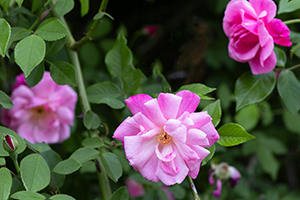
ANTIQUE ROSE EMPORIUM
Independence, Washington County
Old Blush Rose and other antique Texas rose varieties
IF YOU GO
10000 FM 50, Brenham
Nursery and gardens open 9 a.m.-5:30 p.m. Monday through Saturday, 11 a.m.-5:30 p.m. Sunday
979-836-5548
antiqueroseemporium.com
There’s no shortage of roses in the Bluebonnet region, but among the 330 varieties available at the Antique Rose Emporium, 11 miles north of Brenham, there is one with a particularly rich history. Old Blush is one of the first rose varieties grown in Texas, brought by European settlers in the mid-1800s. Also known as Parsons’ Pink China, this rose bush with soft lilac-pink blooms originated about a thousand years ago in China, and appeared in Europe in the mid- to late-1700s.
The emporium sells about 45 true antique or old garden roses — defined as varieties existing before 1867, according to the American Rose Society. Old roses in Texas have been found growing wild in cemeteries, vacant lots and near old homes, including in eastern Central Texas.
An Old Blush bush was rediscovered in the 1970s, according to a story in Texas Monthly magazine, when rose aficionado Pamela Puryear said she found it growing in front of an 1824 log house in Washington County.
Old Blush, like many heirloom roses, is tough, disease-resistant and can flourish in rugged soil without much human help. Its medium-sized, semi-double blooms have a soft fruity fragrance. Like other old roses, it can grow as a hedge, border or the bushy star of a garden.

